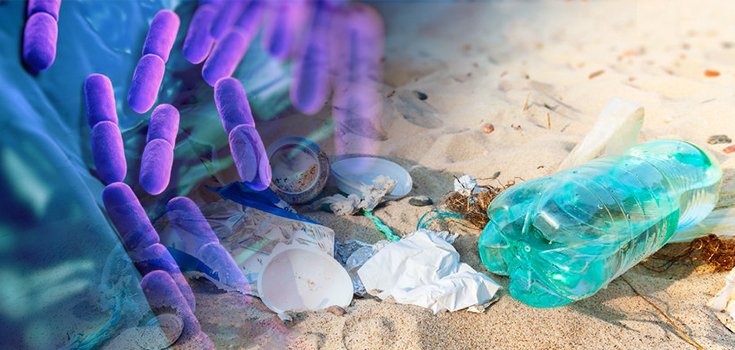Huge Discovery: Bacterium that “Eats” Plastic Waste

The world’s oceans are filled with plastic. More than 5 million pieces of it are floating around, being eaten by fish and passed up the food chain. Every year, more than 100,000 marine animals and seabirds are killed by plastic waste.

Of the 342 million tons of plastic produced each year, a tiny fraction of it – about 14% – is recyclable.
That’s a lot of plastic, and it hasn’t even been around that long. If you’re older than 70, you’ve been around longer than plastic.
One particular plastic, PET, is considered a major environmental hazard because it’s so resistant to break down. In 2013, about 61 million tons of the super durable plastic was produced worldwide. Until now, the only thing known to degrade PET were rare fungi. But Japanese scientists have discovered a bacterium that that can break down PET completely into carbon dioxide and water. [1]
The bacterium, Ideonella sakaiensis, was found outside of a bottle recycling plant. The pathogen appears to have evolved a pair of enzymes it uses to break down PET.
The bacterium can almost completely break down a thin film of PET after 6 weeks at a temperature of 86 degrees Fahrenheit. According to the researchers, appendages from the cells might have secreted compounds that helped to dissolve the plastic.
The University of Hull’s
“You may think this is the rerun of an old story, as plastic-eating microbes have already been touted as saviors of the planet. But there are several important differences here. First, previous reports were of tricky-to-cultivate fungi, where in this case the microbe is easily grown. The researchers more or less left the PET in a warm jar with the bacterial culture and some other nutrients, and a few weeks later all the plastic was gone.”
But the bacterium is still struggling to break down PET, so it’s going to take more time and research before scientists can harness the power of Ideonella sakaiensis and use it to truly recycle plastics. Don’t start tossing stuff out of your car window just yet.
Study author Kenji Miyamoto of Keio University, explained:
“It’s difficult to break down highly crystallized PET. “Our research results are just the initiation for the application. We have to work on so many issues needed for various applications. It takes a long time.”
There’s also an important obstacle that needs to be overcome first.
Using bacteria to break down plastic could release molecules and compounds that could be harmful to the environment. But if Ideonella sakaiensis can’t be used in the environment, there is still potential for it to be used in the lab to create a synthetic substance that “eats” plastic. [2]
Despite plastic being relatively “young,” the researchers said the fact that one organism has already evolved the ability to consume it suggests that other microbes exist that can eat PET and other kinds of plastic, which could revolutionize the way we recycle waste.

[1] CBS News

You called this bacterium a pathogen. Is this correct? Can it cause illness?